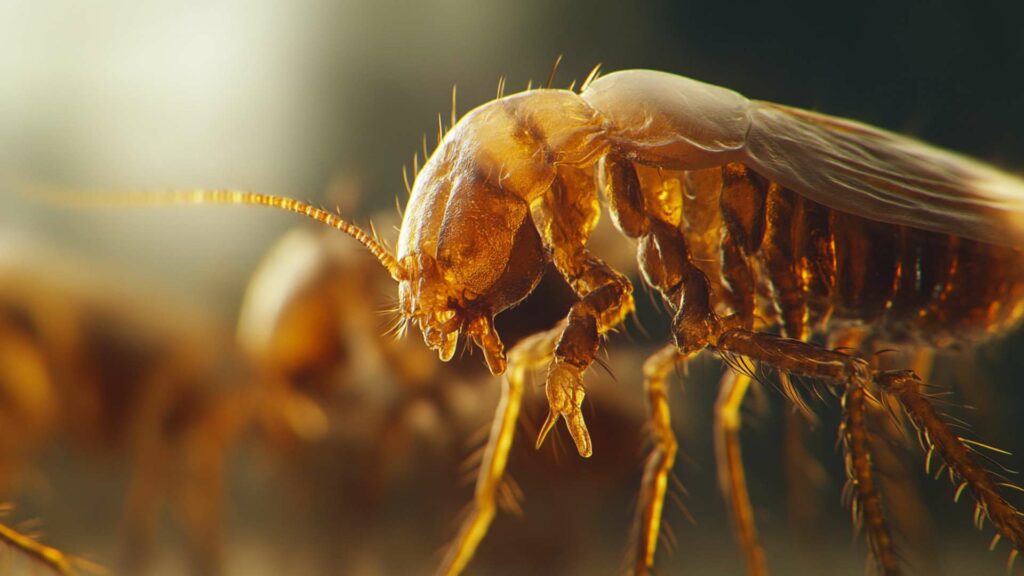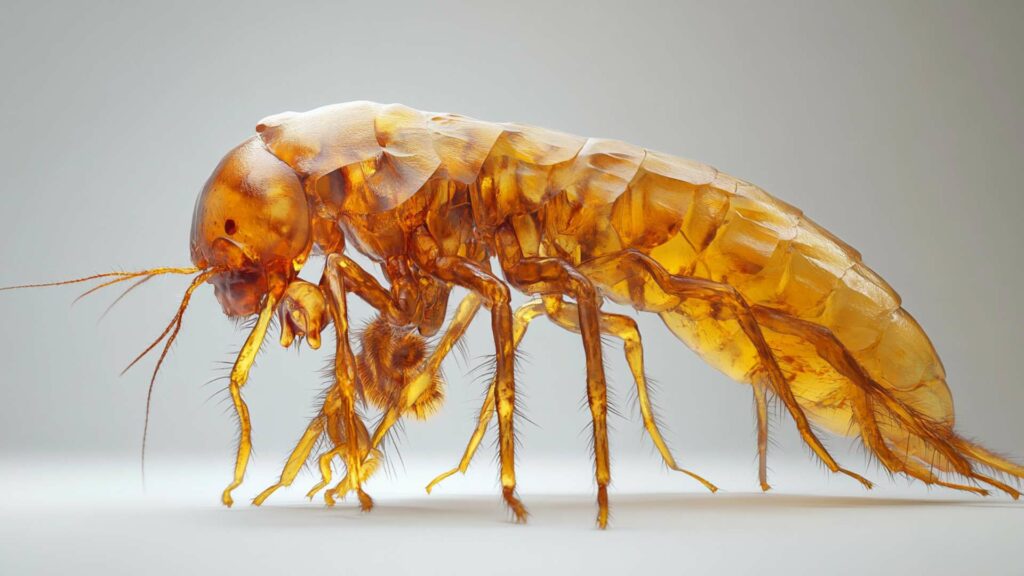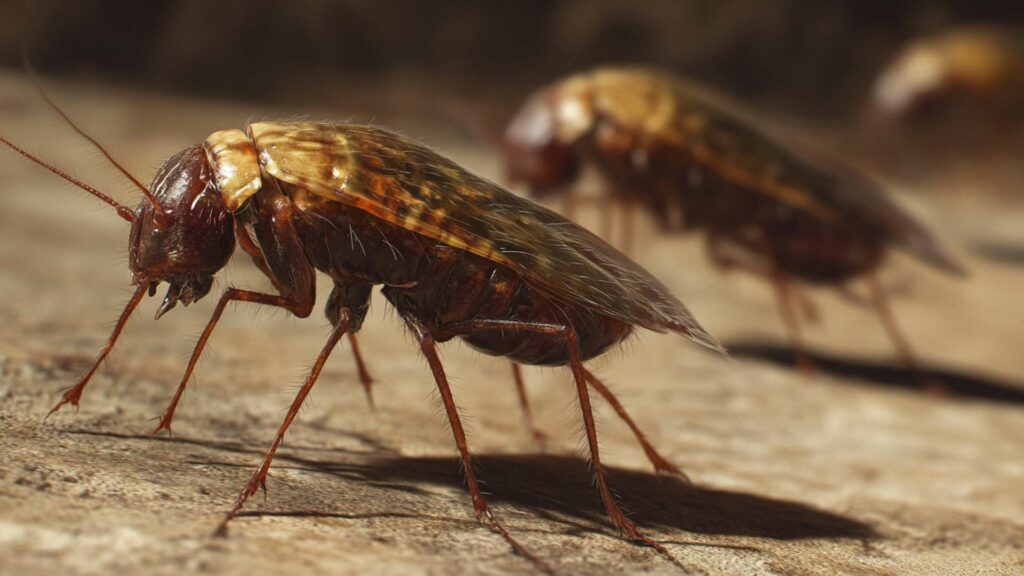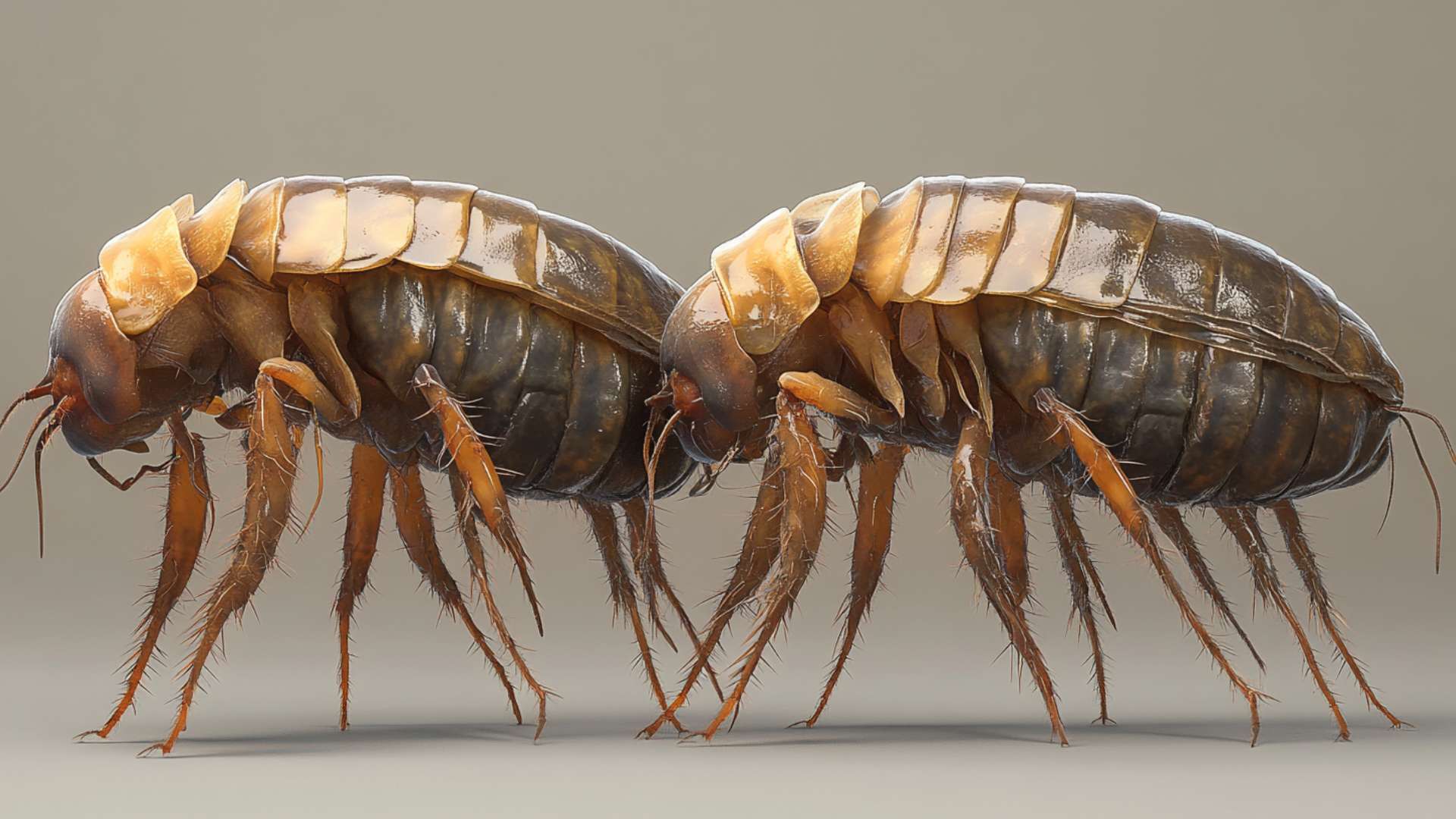Fleas, those tiny, pesky creatures that infest our beloved pets, can quickly turn into a nightmare if left unchecked. Not only do fleas cause immense discomfort to our furry friends by incessantly biting and causing itching, but they can also transmit diseases and lead to secondary infections. Maintaining proper flea control is essential not only for the well-being of our four-legged companions but also for the overall cleanliness and hygiene of our households.
The menace of fleas goes beyond just causing itchiness; these insects are prolific breeders capable of laying thousands of eggs in their short lifespan. This means that even a small flea infestation can quickly escalate into a full-blown invasion if not addressed promptly.
Additionally, fleas are known carriers of other pests like ticks, which can transmit diseases such as Lyme disease and cause further discomfort to both pets and humans. To combat this persistent problem, various types of flea control products have been developed over the years.
These products aim to kill adult fleas, prevent re-infestation by targeting flea eggs or larvae, or eliminate other parasites like ticks. Understanding the different options available is crucial for selecting the most appropriate product based on your pet’s needs and preferences.
Overview of different types of flea control products

When it comes to flea control products, pet owners are spoilt for choice. The market offers an array of solutions that cater to different lifestyles and preferences. The three main categories include flea collars, topical treatments (also known as spot-on solutions), and oral medications.
Flea collars have long been a trusted method in the battle against fleas. These collars work by releasing active ingredients that repel flea dirt or kill adult fleas on contact.
Some traditional collars contain insecticides as their primary active ingredient, while others offer natural or herbal alternatives. Flea collars are known for their ease of use and long-lasting effects, making them a popular choice among pet owners.
Topical treatments, on the other hand, are liquid solutions that are applied directly to the skin of your pet. These products typically come in small tubes and contain active ingredients that spread over the body through natural oils in the dog’s skin.
They provide targeted flea control and often boast additional benefits such as tick prevention or protection against other parasites. Topical treatments like Advantage, Frontline, Revolution, and others have gained popularity among dog fleas, due to their effectiveness and ease of application.
Oral medications have emerged as a convenient alternative for pet owners seeking an easy way to control fleas from the inside out. Available in various forms such as chewable tablets or oral liquids, these products are ingested by your pet and work systemically to kill fleas once they bite your furry friend.
Brands like NexGard, Bravecto, and Sentinel Spectrum, among others, have revolutionized flea control with their oral treatments that also help prevent heartworms or treat tick infestations simultaneously. By having an overview of these different types of both flea and tick control products, you can make an informed decision about which approach best suits your pet’s needs.
It is crucial to consider factors such as efficacy against fleas at different stages of their life cycle (including killing adult fleas), safety considerations for pets on specific medications (especially large dogs), and additional benefits provided by certain overviews of flea control products, like tick prevention or prevention against other pests. Be sure to continue reading this article as we delve deeper into each category of flea control product—exploring their mechanism of action, pros, and cons—so you can choose the ideal solution tailored specifically for your furry companion’s needs.
Flea Collars: A Classic Approach

How flea collars work to repel and kill fleas
Flea collars have been a popular choice for pet owners seeking a reliable and long-lasting method of flea control. These collars are designed to repel and kill fleas, as well as other common pests such as ticks, chewing lice, and even certain mites like sarcoptic mange.
The mechanism behind their effectiveness lies in the active ingredients integrated into the collar’s material. These ingredients are slowly released over time, spreading through your dog’s fur and creating a protective barrier against these pesky intestinal parasites themselves.
Different types of flea collars available in the market
When it comes to flea collars, you’ll find two main types available in the market: traditional flea collars with insecticides and natural or herbal flea collars without chemicals. Traditional flea collars usually contain insecticides like organophosphates or pyrethroids, which are effective at killing or repelling fleas either on contact or interrupting their life cycle. On the other hand, natural or herbal flea collars often utilize essential oils such as citronella or eucalyptus to repel fleas naturally without relying on synthetic chemicals.
Traditional flea collars with insecticides
The traditional variety of flea and tick collars often incorporates active ingredients that act directly on adult fleas by killing them upon contact. Some well-known brands include Seresto Flea Collar which contains imidacloprid and flumethrin, providing up to 8 months of continuous protection against fleas and ticks for dogs with medium-sized necks up to 27″. These insecticidal collar options are an efficient choice for pet owners looking for prolonged efficacy without having to frequently reapply topical treatments.
Natural or herbal flea collars without chemicals
For those who prefer a more natural approach to flea control, herbal or natural flea collars are gaining popularity. These collars utilize essential oils known for their insect-repelling properties.
They are typically free from harsh chemicals and pesticides, making them a suitable option for pet owners concerned about potential side effects or allergies. However, it’s important to note that while these collars may repel fleas, they may not offer the same level of efficacy in killing fleas or interrupting their life cycle as insecticidal collars do.
Pros and cons of using flea collars for flea control
Flea collars come with their own set of advantages and drawbacks. On the positive side, they provide continuous protection against fleas and other parasites without requiring frequent application like topical treatments do.
Additionally, they are relatively easy to use—simply fasten the collar around your pet’s neck according to instructions—and are generally well-tolerated by most dogs. Flea collars can also be a cost-effective solution in the long run compared to purchasing multiple topical treatments.
However, it’s important to consider some potential disadvantages as well. Some dogs may develop skin irritation or allergies from certain collar materials or active ingredients, although this is relatively uncommon.
Additionally, while flea collars are effective at repelling fleas in the neck area where they are worn, they may not provide comprehensive protection for your pet’s entire body. It is therefore advisable to combine collar usage with other flea control methods such as regular bathing and spot-on products for optimal coverage.
Flea collars offer a classic approach to flea control that has stood the test of time. Their functionality lies in repelling and killing fleas through active ingredients integrated into the collar material.
Pet owners have choices between traditional insecticidal collar options or more natural alternatives utilizing essential oils. While there are pros and cons to consider, flea collars can provide continuous protection against fleas and other parasites, making them a viable option for pet owners seeking long-lasting solutions for their furry companions.
Topical Treatments: Spot-On Solutions

Understanding how topical treatments work against fleas
When it comes to combating fleas, topical treatments are a go-to solution for many pet parents. These spot-on topical products offer a convenient and effective way to eliminate fleas and prevent future infestations.
But how exactly do these magical potions work? Well, let me break it down for you.
Topical flea treatments usually come in small vials or tubes containing liquid substances that are applied directly onto your furry friend’s skin, typically between their shoulder blades or along the back of their necks. Once applied, the active ingredients in these products spread across the skin and coat through natural oils, effectively killing fleas at various life stages, including eggs, larvae, and adult fleas.
Popular brands offering spot-on treatments for fleas
When it comes to choosing a spot-on product for flea control, there are several popular brands that have proven their efficacy over time. Advantage, Frontline, and Revolution are among the top contenders in this game. Advantage is known for its fast-acting formula that kills adult fleas within minutes of application.
Frontline has gained popularity due to its ability to repel not only fleas but also ticks and chewing lice effectively. Revolution takes things up a notch by not only eliminating fleas but also protecting against other pests like heartworms and intestinal worms.
Application process and frequency of use for optimal results
Applying a topical flea and tick treatment that might seem like rocket science at first glance but fear not! It’s actually quite simple.
Start by parting your pet’s fur at the base of their neck or between their shoulder blades until you can see the skin below. Squeeze the contents of the tube directly onto the skin while making sure you’re avoiding contact with their eyes or mouth.
Massage the area gently to help distribute the product evenly. Remember, different brands may have slightly different application methods, so always read and follow the instructions provided by the manufacturer for optimal results.
As for frequency of use, it depends on the specific topical product that you choose. Some topical treatments provide protection for up to a month, while others might require more frequent applications.
It’s important to adhere to the recommended schedule as specified by the manufacturer to ensure maximum effectiveness and protect your furry friend from future flea infestations. Keep in mind that larger dogs may require higher doses or multiple tubes to ensure proper coverage, so always check the label or consult your veterinarian if you’re uncertain about dosing guidelines for your pet.
Topical flea and tick treatments are a popular choice among dog owners due to their ease of use and effectiveness in combating fleas at various life stages. Advantage, Frontline, and Revolution are just a few trusted brands that offer spot-on solutions for fleas.
The application process is straightforward, involving direct application onto your pet’s skin while avoiding sensitive areas like eyes and mouth. By adhering to the recommended frequency of use based on your chosen product’s instructions, you can ensure optimal results in keeping those pesky fleas at bay and providing your furry companion with much-needed relief from these tiny but troublesome critters.
Oral Medications: From Inside Out Protection

A Convenient Option for Flea Control
When it comes to fighting fleas and keeping our furry friends safe, oral medications have emerged as a convenient and effective option. Unlike topical treatments, which need to be applied externally, oral medications provide protection from the inside out. This means that once ingested, these medications circulate through your pet’s bloodstream and work their magic by either killing fleas or preventing them from reproducing.
Different Types of Oral Medications Available
There are two primary types of oral medications available for flea-control treated dogs: prescription-based oral tablets and over-the-counter chewable tablets. Prescription-based oral tablets are typically recommended by veterinarians, as they require a prescription due to their stronger formula. These tablets contain potent ingredients that directly target fleas and prevent infestations in pets.
On the other hand, over-the-counter chewable tablets provide an accessible option for pet parents seeking convenience without sacrificing effectiveness. These chewables come in various flavors which make them palatable for pets to consume willingly, making medication time less of a struggle.
Comparing Different Brands and Their Efficacy
When it comes to over-the-counter chewable tablets for flea control, popular brands like NexGard, Bravecto, Sentinel Spectrum, and others have gained recognition for their efficacy against fleas. Each brand utilizes specific active ingredients that target different stages of the flea life cycle and offer varying durations of protection.
While NexGard is known for its ability to kill adult fleas before they have a chance to lay eggs in your pet’s fur, Bravecto provides extended protection by preventing reinfestation for up to medium dogs for 12 weeks. Sentinel Spectrum not only kills adult fleas but also tackles other pesky critters like ticks and chewing lice that may pose a threat to your pet’s well-being.
Safety Considerations When Using Oral Medications
It’s crucial to consider safety when administering oral medications to your beloved pets. While these products are generally safe, certain precautions should be taken.
Always follow the recommended dosage guidelines provided by the manufacturer or prescribed by your veterinarian. Overdosing can lead to adverse effects on your pet’s health.
Additionally, be aware of any potential allergic reactions in your furry friend. While rare, some pets may have hypersensitivity to specific ingredients found in oral medications.
If you notice any signs of discomfort or unusual behavior after administering an oral medication, consult with your veterinarian promptly. Remember, oral medications are a reliable and convenient option for flea control that can provide peace of mind to both you and your pet.
However, it is always best to consult with a veterinarian before starting any flea control regimen, as they can guide you in selecting the most suitable product based on your pet’s individual needs and health condition. By choosing the right oral medication and following proper administration guidelines, you’ll be one step closer to freeing your beloved companion from those pesky fleas that disrupt their comfort and happiness.
Combination Approaches: Maximizing Flea Control Effectiveness
The Power of Synergy: Benefits of Combining Different Flea Control Products
When it comes to combating fleas and ensuring the well-being of our furry friends, using a single flea control product may not always be enough. By combining different flea control methods, we can maximize the effectiveness of our efforts and provide comprehensive protection against these pesky parasites.
The synergy achieved through combination approaches allows us to target different stages of the flea life cycle and address various concerns such as tick prevention, repelling fleas, or treating other common issues like sarcoptic mange or ear mites. One major advantage of combining flea control products is their ability to target multiple aspects of flea infestation.
While oral medications work from the inside out by killing adult fleas and stopping their reproductive cycle, topical treatments provide immediate relief by killing adult fleas on contact and repelling new ones. Adding a flea collar into the mix further enhances protection and kills fleas by forming a barrier around your pet’s neck that prevents fleas from infesting their head region where they tend to congregate.
Examples of Combination Approaches:
1. Using a Topical Treatment Along with a Collar Combining a topical spot-on treatment with a flea collar is an excellent way to create an all-encompassing defense against fleas.
Start by applying the topical treatment between your pet’s shoulder blades, ensuring direct contact with their skin. This will kill adult fleas already present on your pet and repel future infestations.
Then, add a quality flea collar around your pet’s neck, adjusting it snugly but comfortably to allow for free movement. The combined power of these two methods provides long-lasting protection against both adult fleas and their eggs or larvae in your dog’s environment.
Moreover, this approach offers added benefits such as tick prevention, as certain flea collars also repel ticks, safeguarding your pet against a variety of parasites.
2. Pairing an Oral Medication with a Spot-On Treatment
Another effective combination approach involves using an oral medication in conjunction with a spot-on treatment. Administer the prescribed oral medication to your pet according to the recommended dosage and frequency.
These medications effectively kill adult fleas that bite your pet, preventing infestations from taking hold. To complement this internal tick protection alone, apply a spot-on treatment along your dog’s back where they cannot lick it off.
Topical flea treatments contain active ingredients that are toxic to fleas but safe for pets when used correctly. This combination approach tackles fleas from both inside and outside, eradicating existing infestations and offering continuous protection against new ones.
Tips for Safely Implementing Combination Approaches
While combining different flea control products can be highly effective, it’s crucial to follow some essential guidelines to ensure the safety and well-being of our beloved pets:
1. Consult with your veterinarian: Before starting any combination approach, consult with your veterinarian to determine which products are suitable for your pet’s age, weight, breed, and any underlying health conditions they may have.
2. Follow product instructions: Carefully read and adhere to the instructions provided by each product manufacturer regarding proper usage, application techniques, dosages (for oral medications), and duration of use.
3. Avoid overloading: Be cautious not to overload your pet with multiple treatments simultaneously or mix incompatible products without consulting a professional. Using too many chemical agents at once can potentially harm or stress your furry friend unnecessarily.
4. Monitor closely for adverse reactions: Keep a close eye on your pet after implementing any combination approach. Watch out for any signs of adverse reactions such as excessive itching or scratching at application sites or unusual behavior patterns. If you notice anything concerning, contact your veterinarian immediately.
By utilizing combination approaches, we can harness the power of different flea control products to create an effective shield against these nuisances. Remember, a proactive and comprehensive approach is key to ensuring our pets remain free from fleas and other common issues like ticks or ear mites.
Alternative Flea Control Methods: Thinking Outside the Box
Natural Remedies and Home Remedies for Flea Control
While flea collars, topical treatments, and oral medications are commonly used for flea control, some pet parents prefer a more natural approach. There are various natural remedies and home remedies that can be effective in repelling fleas. For instance, using essential oils like lavender, eucalyptus, or cedarwood mixed with water can create a homemade flea spray that can be applied to your pet’s fur.
Additionally, regularly washing your pet’s bedding with warm water can help eliminate fleas and their eggs. However, it is important to consult with a veterinarian before trying any natural or home remedies to ensure they are safe for your furry friend.
The Power of Vacuuming and Cleaning

Another alternative method for flea control is maintaining a clean environment through regular vacuuming and cleaning. Fleas lay eggs in carpets, furniture, and other areas where pets spend time.
By vacuuming thoroughly and frequently in these areas, you can remove adult fleas as well as prevent reinfestation by eliminating eggs and larvae. It is also recommended to wash your pet’s bedding regularly in hot water to kill any existing fleas.
Flea Comb: A Hands-On Approach

A flea comb is a simple yet effective tool that allows you to physically remove adult fleas from your pet’s fur. This method works particularly well for dogs with short hair or those who have only a few fleas present.
Gently combing through your pet’s fur with a fine-toothed comb will trap the fleas within its teeth, allowing you to dispose of them in soapy water afterward. While this method may not provide continuous protection like other products mentioned earlier, it can offer immediate relief by reducing the number of adult fleas on your pet.
Environmental Control: Targeting Fleas in Your Yard

To prevent fleas from infesting your home, it is crucial to address the environment outside as well. A combination of strategies can help control fleas in your yard.
First, regularly mow and trim your lawn, as fleas tend to thrive in tall grass and shady areas. Additionally, you can consider using nematodes (beneficial microscopic worms) that feed on flea larvae in the soil.
These can be purchased at garden centers or online and applied according to the instructions provided. Removing any debris or piles where fleas might hide can significantly reduce their population in your yard.
Conclusion
While flea collars, topical treatments, and oral medications are effective options for controlling fleas on dogs and preventing reinfestation, alternative methods can also play a role in overall flea control strategies. Natural remedies and home remedies offer pet parents a more holistic approach that may work well for some individuals.
Additionally, incorporating regular vacuuming and cleaning into your routine helps eliminate fleas from the environment. Hands-on methods like flea combing provide immediate relief by physically removing adult fleas from your pet’s fur.
Addressing the outdoor environment through proper yard maintenance and targeted measures can significantly reduce the risk of flea infestation. By tailoring a comprehensive approach that combines various methods, you can ensure effective flea control while keeping your furry friend happy and itch-free.
Remember: prevention is key! Regularly treating your pets with recommended products provides continuous protection not only against fleas but also ticks, preventing heartworms and intestinal worms as well as keeping them safe from harmful pests like chewing lice or American dog ticks.
Wipe out fleas with D-Termination: The top pest control service in Las Vegas!

If you’re dealing with flea issues on your Las Vegas property, count on D-Termination for assistance. Our expert team specializes in eliminating flea infestations and restoring comfort and peace to your space. Bid farewell to fleas—opt for D-Termination for effective pest control today!
Reach out to us at 702-919-6310 or visit dtermination.com to book your flea control service and reclaim your space from these troublesome pests.
Frequently Asked Questions:
The effectiveness of topical or oral flea treatment for dogs depends on various factors, including the specific product and your dog’s preferences or health conditions.
Flea collars and some flea products may not be recommended due to potential side effects, skin sensitivity, or the presence of alternative, more effective treatments.
Consult your veterinarian before combining oral and topical flea treatments to ensure safety and effectiveness.
Combining a flea collar with oral flea treatment is generally not recommended without consulting a veterinarian, as it could lead to excessive chemical exposure.








